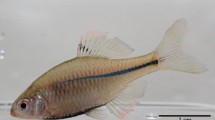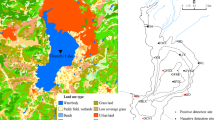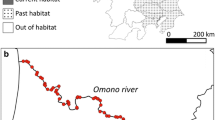Abstract
Assessment of distribution pattern of species with small populations is a prerequisite for conservation efforts. In our investigation, we evaluated the use of environmental DNA (eDNA) in assessing the presence and distribution pattern of a vulnerable fish species in Pranmati hill stream, a tributary of Pinder river in Chamoli, Uttarakhand. Fish specimens caught at one of the sites were classified as Schizothorax richardsonii after morphometric and meristic analysis. DNA isolated from these individuals was subjected to PCR for barcoding. DNA barcode confirmed that the sampled individuals belonged to S. richardsonii. We developed a real-time quantitative polymerase chain reaction (qPCR) assay to target 112 bp sequence of S. richardsonii COI gene. The primers on in silico analysis showed specificity for COI gene of Schizothorax spp. qPCR was employed to quantify the Schizothorax spp. DNA in eDNA samples collected from the four sampling sites on the Pranmati stream. Schizothorax spp. DNA was found in three out of four sites. Detection of Schizothorax spp. DNA at sites where fish specimens were neither visible nor caught, reinforces the importance of use of eDNA in sampling for rare and endangered species. This study demonstrates the efficacy of eDNA detection method for determining the distribution pattern of thinly populated fish species and can be employed to detect their presence at sites where it is difficult to locate or catch them, and can be made use of, while devising conservation strategies.





Similar content being viewed by others
Data availability
The data generated during and/or analyzed during the current study are available from the corresponding author on reasonable request.
References
Agarwal NK, Rawat US, Singh G (2019) Fish assemblages and habitat ecology of river Pinder in central Himalaya, India. Iran J Fish Sci 18:1–14. https://doi.org/10.22092/ijfs.2018.118930
Allard L, Grenouillet G, Khazraie K, Tudesque L, Vigouroux R, Brosse S (2014) Electrofishing efficiency in low conductivity neotropical streams: towards a non-destructive fish sampling method. Fish Manag Ecol 21:234–243. https://doi.org/10.1111/fme.12071
Ardura A, Planes S, Garcia-Vazquez E (2013) Applications of DNA barcoding to fish landings: authentication and diversity assessment. ZooKeys 365:49–65. https://doi.org/10.3897/zookeys.365.6409
Barbarossa V, Bosmans J, Wanders N, King H, Bierkens MF, Huijbregts MA, Schipper AM (2021) Threats of global warming to the world’s freshwater fishes. Nat Commun 12:1–10. https://doi.org/10.1038/s41467-021-21655-w
Barnes MA, Turner CR, Jerde CL, Renshaw MA, Chadderton WL, Lodge DM (2014) Environmental conditions influence eDNA persistence in aquatic systems. Environ Sci Technol 48:1819–1827. https://doi.org/10.1021/es404734
Bhattacharya M, Sharma AR, Patra BC, Sharma G, Seo E-M, Nam J-S, Chakraborty C, Lee S-S (2016) DNA barcoding to fishes: current status and future directions. Mitochondr DNA, Part a, DNA Mapping, Sequencing, and Analysis 27:2744–2752. https://doi.org/10.3109/19401736.2015.1046175
Biggs J, Ewald N, Valentini A, Gaboriaud C, Dejean T, Griffiths RA, Dunn F (2015) Using eDNA to develop a national citizen science-based monitoring programme for the great crested newt (Triturus cristatus). Biol Conserv 183:19–28. https://doi.org/10.1016/j.biocon.2014.11.029
Bingpeng X, Heshan L, Zhilan Z, Chunguang W, Yanguo W, Jianjun W (2018) DNA barcoding for identification of fish species in the Taiwan strait. PLoS ONE 13:1–13. https://doi.org/10.1371/journal.pone.0198109
Cao H, Shockey JM (2012) Comparison of TaqMan and SYBR Green qPCR methods for quantitative gene expression in tung tree tissues. J Agr Food Chem 60:12296–12303. https://doi.org/10.1021/jf304690e
Day F (1888) The fishes of India: being a natural history of the fishes known to inhabit the seas and fresh waters of India, Burma, and Ceylon. William Dawson and Sons Ltd., London
Dayrat B (2005) Towards integrative taxonomy. Biol J Linn Soc 85:407–417. https://doi.org/10.1111/j.1095-8312.2005.00503.x
Deiner K, Altermatt F (2014) Transport distance of invertebrate environmental DNA in a natural river. PLoS ONE 9:e88786. https://doi.org/10.1371/journal.pone.0088786
Dejean T, Valentini A, Miquel C, Taberlet P, Bellemain E, Miaud C (2012) Improved detection of an alien invasive species through environmental DNA barcoding: the example of the American bullfrog Lithobates catesbeianus. J Appl Ecol 49:953–959. https://doi.org/10.1111/j.1365-2664.2012.02171.x
Djurhuus A, Port J, Closek CJ, Yamahara KM, Romero-Maraccini O, Walz KR, Goldsmith DB, Michisaki R, Breitbart M, Boehm AB, Chavez FP (2017) Evaluation of filtration and DNA extraction methods for environmental DNA biodiversity assessments across multiple trophic levels. Front Mar Sci 4:314. https://doi.org/10.3389/fmars.2017.00314
Doi H, Inui R, Akamatsu Y, Kanno K, Yamanaka H, Takahara T, Minamoto T (2017) Environmental DNA analysis for estimating the abundance and biomass of stream fish. Freshw Biol 62:30–39. https://doi.org/10.1111/fwb.12846
Doi H, Minamoto T, Takahara T, Tsuji S, Uchii K, Yamamoto S, Yamanaka H (2021) Compilation of real-time PCR conditions toward the standardization of environmental DNA methods. Ecol Res 36:379–388. https://doi.org/10.1111/1440-1703.12217
Evans NT, Lamberti GA (2018) Freshwater fisheries assessment using environmental DNA: a primer on the method, its potential, and shortcomings as a conservation tool. Fish Res 197:60–66. https://doi.org/10.1016/j.fishres.2017.09.013
Ficetola GF, Miaud C, Pompanon F, Taberlet P (2008) Species detection using environmental DNA from water samples. Biol Lett 4:423–425. https://doi.org/10.1098/rsbl.2008.0118
Godornes C, Leader BT, Molini BJ, Centurion-Lara A, Lukehart SA (2007) Quantitation of rabbit cytokine mRNA by real-time RT-PCR. Cytokine 38:1–7. https://doi.org/10.1016/j.cyto.2007.04.002
Goldberg CS, Pilliod DS, Arkle RS, Waits LP (2011) Molecular detection of vertebrates in stream water: a demonstration using Rocky mountain tailed frogs and Idaho giant salamanders. PLoS ONE 6:e22746. https://doi.org/10.1371/journal.pone.0022746
Goldberg CS, Strickler KM, Pilliod DS (2015) Moving environmental DNA methods from concept to practice for monitoring aquatic macroorganisms. Biol Conserv 183:1–3. https://doi.org/10.1016/j.biocon.2014.11.040
Goldberg CS, Turner CR, Deiner K, Klymus KE, Thomsen PF, Murphy MA, Taberlet P (2016) Critical considerations for the application of environmental DNA methods to detect aquatic species. Methods Ecol Evol 7:1299–1307. https://doi.org/10.1111/2041-210X.12595
Guillera-Arroita G, Lahoz-Monfort JJ, Van Rooyen AR, Weeks AR, Tingley R (2017) Dealing with false positive and false negative errors about species occurrence at multiple levels. Methods Ecol Evolu 8:1081–1091. https://doi.org/10.1111/2041-210X.12743
Hernandez PA, Graham CH, Master LL, Albert DL (2006) The effect of sample size and species characteristics on performance of different species distribution modeling methods. Ecography 29:773–785. https://doi.org/10.1111/j.0906-7590.2006.04700.x
Holdaway RJ, Wood JR, Dickie IA, Orwin KH, Bellingham PJ, Richardson SJ, Lyver POB, Timoti P, Buckley TR (2017) Using DNA metabarcoding to assess New Zealand’s terrestrial biodiversity. New Zealand J Ecol 41:251–262. https://doi.org/10.2307/26198807
Holden MJ, Raitt DFS (1974) Manual of fisheries science. Part 2-methods of resource investigation and their application FAO 1:223 https://agris.fao.org/agris-search/search.do?recordID=XF7600305
Ikeda K, Doi H, Tanaka K, Kawai T, Negishi JN (2016) Using environmental DNA to detect an endangered crayfish Cambaroides japonicus in streams. Conservation Genet Resour 8:231–234. https://doi.org/10.1007/s12686-016-0541-z
Jane SF, Wilcox TM, McKelvey KS, Young MK, Schwartz MK, Lowe WH, Letcher BH, Whiteley AR (2015) Distance, flow and PCR inhibition: eDNA dynamics in two headwater streams. Mol Ecol Resour 15:216–227. https://doi.org/10.1111/1755-0998.12285
Jerde C, Mahon A, Chadderton W, Lodge D (2011) Sight unseen detection of environmental DNA for surveillance of aquatic organisms at low densities. Conserv Lett 4:150–157. https://doi.org/10.1111/j.1755-263X.2010.00158.x
Keskin E (2014) Detection of invasive freshwater fish species using environmental DNA survey. Biochem Syst Ecol 56:68–74. https://doi.org/10.1016/j.bse.2014.05.003
Klymus KE, Merkes CM, Allison MJ, Goldberg CS, Helbing CC, Hunter ME, Richter CA (2020a) Reporting the limits of detection and quantification for environmental DNA assays. Environ DNA 2:271–282. https://doi.org/10.1002/edn3.29
Klymus KE, Ramos DVR, Thompson NL, Richter CA (2020) Development and testing of species-specific quantitative PCR assays for environmental DNA applications. JoVE 165:e61825. https://doi.org/10.3791/61825
Krishan NR, Negi T (2010) Analysis of morphometric characters of Schizothorax richardsonii (Gray, 1832) from the Uttarkashi District of Uttrakhand State, India. J Biol Sci 10:536–540. https://doi.org/10.3923/jbs.2010.536.540
Lahoz-Monfort JJ, Guillera-Arroita G, Tingley R (2016) Statistical approaches to account for false-positive errors in environmental DNA samples. Mol Ecol Resour 16:673–685. https://doi.org/10.1111/1755-0998.12486
Laramie MB, Pilliod DS, Goldberg CS (2015) Characterizing the distribution of an endangered salmonid using environmental DNA analysis. Biol Conserv 183:29–37. https://doi.org/10.1016/j.biocon.2014.11.025
McCabe D (2010) Rivers and streams: life in flowing water. Nature Education Knowledge 1:4. https://www.uvm.edu/~epscor/pdfFiles/pubs/McCabe_Rivers_And_Streams.pdf. Accessed 29 Jan 2022
Pawlowski J, Apothéloz-Perret-Gentil L, Altermatt F (2020) Environmental DNA: what’s behind the term? Clarifying the terminology and recommendations for its future use in biomonitoring. Mol Ecol 29:4258–4264. https://doi.org/10.1111/mec.15643
Piggott MP, Banks SC, Broadhurst BT, Fulton CJ, Lintermans M (2021) Comparison of traditional and environmental DNA survey methods for detecting rare and abundant freshwater fish. Aquat Conserv 31:173–184. https://doi.org/10.1002/aqc.3474
Pilliod DS, Goldberg CS, Arkle RS, Waits LP (2014) Factors influencing detection of eDNA from a stream-dwelling amphibian. Mol Ecol Resour 14:109–116. https://doi.org/10.1111/1755-0998.12159
Plante F, Bourgault P, Dubois Y, Bernatchez L (2021) Environmental DNA as a detection and quantitative tool for stream-dwelling salamanders: a comparison with the traditional active search method. Environ DNA 3:1128–1141. https://doi.org/10.1002/edn3.233
Polanco Fernández A, Marques V, Fopp F, Juhel JB, Borrero-Pérez GH, Cheutin MC, Dejean T, González Corredor JD, Acosta-Chaparro A, Hocdé R et al (2021) Comparing environmental DNA metabarcoding and underwater visual census to monitor tropical reef fishes. Environ DNA 3:142–156. https://doi.org/10.1002/edn3.140
Portt CB, Coker G, Ming D, Randall RG (2006) A review of fish sampling methods commonly used in Canadian freshwater habitats. Can Tech Rep Fish Aquat Sci 2604. https://www3.epa.gov/region1/npdes/merrimackstation/pdfs/ar/AR-1240.pdf. Accessed 12 Dec 2021
Rasmussen RS, Morrissey MT, Hebert PD (2009) DNA barcoding of commercially important salmon and trout species (Oncorhynchus and Salmo) from North America. J Agric Food Chem 57:8379–8385. https://doi.org/10.1021/jf901618z
Rees HC, Maddison BC, Middleditch DJ, Patmore JR, Gough KC (2014) The detection of aquatic animal species using environmental DNA—a review of eDNA as a survey tool in ecology. J Appl Ecol 51:1450–1459. https://doi.org/10.1111/1365-2664.12306
Remya M, Sherly W (2018) A study of morphometry and meristic counts of Oxyurichthys tentacularis, Gobiidae (Valenciennes, 1837) from Ashtamudi lake-Kollam, Kerala. Int J Fish Aquacult Sci 8:13–18. https://www.ripublication.com/irph/ijfas18/ijfasv8n1_02.pdf
Sehgal KL (1999) Coldwater fish and fisheries in the Indian Himalayas: rivers and streams. FAO Fisheries Technical Paper Rome 385:41–63
Sharma A, Dubey VK, Johnson JA, Rawal YK, Sivakumar K (2021) Dendritic prioritization through spatial stream network modeling informs targeted management of Himalayan riverscapes under brown trout invasion. J Appl Ecol 58:2415–2426. https://doi.org/10.1111/1365-2664.13997
Shogren AJ, Tank JL, Andruszkiewicz E, Olds B, Mahon AR, Jerde CL, Bolster D (2017) Controls on eDNA movement in streams: transport, retention, and resuspension. Sci Rep 7:1–11. https://doi.org/10.1038/s41598-017-05223-1
Takahara T, Minamoto T, Yamanaka H, Doi H, Zi K (2012) Estimation of fish biomass using environmental DNA. PLoS ONE 7:e35868. https://doi.org/10.1371/journal.pone.0035868
Talwar PK, Jhingran AG (1991) Inland fishes of India and adjacent countries. Vols. 1&2. Oxford-IBH Publishing Co. Pvt. Ltd. New Delhi
Teletchea F (2010) After 7 years and 1000 citations: comparative assessment of the DNA barcoding and the DNA taxonomy proposals for taxonomists and non-taxonomists. Mitochondrial DNA 21:206–226. https://doi.org/10.3109/19401736.2010.532212
Thomsen PF, Willerslev E (2015) Environmental DNA—an emerging tool in conservation for monitoring past and present biodiversity. Biol Conserv 183:4–18. https://doi.org/10.1016/j.biocon.2014.11.019
Thomsen PF, Kielgast J, Iversen LL, Wiuf C, Rasmussen M, Gilbert MTP, Orlando L, Willerslev E (2012) Monitoring endangered freshwater biodiversity using environmental DNA. Mol Ecol 21:2565–2573. https://doi.org/10.1111/j.1365-294X.2011.05418.x
Triantafyllidis A, Bobori D, Koliamitra C, Gbandi E, Mpanti M, Petriki O, Karaiskou N (2011) DNA barcoding analysis of fish species diversity in four north Greek lakes. Mitochondrial DNA 22:37–42. https://doi.org/10.3109/19401736.2010.542242
Turner CR, Uy KL, Everhart RC (2015) Fish environmental DNA is more concentrated in aquatic sediments than surface water. Biol Conserv 183:93–102. https://doi.org/10.1016/j.biocon.2014.11.017
Valentini A, Taberlet P, Miaud C, Civade R, Herder J, Thomsen PF, Bellemain E, Besnard A, Coissac E, Boyer F et al (2016) Next-generation monitoring of aquatic biodiversity using environmental DNA metabarcoding. Mol Ecol 25:929–942. https://doi.org/10.1111/mec.13428
Ward RD, Zemlak TS, Innes BH, Last PR, Hebert PD (2005) DNA barcoding Australia’s fish species. Phil Trans R Soc B 360:1847–1857. https://doi.org/10.1098/rstb.2005.1716
Wilcox TM, McKelvey KS, Young MK, Jane SF, Lowe WH, Whiteley AR, Schwartz MK (2013) Robust detection of rare species using environmental DNA: the importance of primer specificity. PLoS ONE 8:e59520. https://doi.org/10.1371/journal.pone.0059520
WWF (2020) Living Planet Report 2020 — bending the curve of biodiversity loss. Almond REA, Grooten M, Petersen T (eds). WWF, Gland, Switzerland. https://www.zsl.org/sites/default/files/LPR%202020%20Full%20report.pdf
Yamanaka H, Minamoto T (2016) The use of environmental DNA of fishes as an efficient method of determining habitat connectivity. Ecol Indic 62:147–153. https://doi.org/10.1016/j.ecolind.2015.11.022
Acknowledgements
We acknowledge Dr. Vimal Singh, Associate Professor, Department of Geology, University of Delhi, for guidance in the field work and for providing the map of Pranmati basin. We also thank the two anonymous reviewers who greatly helped to improve the manuscript.
Funding
The work is supported by Institute of Eminence (IoE), University of Delhi (Research grant IoE/FRP/LS/2020/27 dated: 31.12.2020), and Ministry of Earth Science (MoES) (Research grant MoES/P.O.(Geo)/95/2017 dated: 21.06.2021). Rishikesh Krishan Laxmi (RKL) greatly acknowledges the Department of Zoology, University of Delhi for providing the infrastructural facilities and Council of Scientific and Industrial Research (CSIR) for providing the fellowship.
Author information
Authors and Affiliations
Contributions
Designed the experiment: NS RKL, field work and development of lab protocol: NS RKL, performed the experiment and data analysis: RKL VSR NS, writing, reviewing, and editing: RKL VSR NS.
Corresponding author
Ethics declarations
Ethics approval
The fish were sampled and treated according to the procedures established by Institutional Animal Ethics Committee (IAEC) at University of Delhi under the Committee for the purpose of Control and Supervision of Experiments for Animals (CPCSEA) (file no. DU/ZOOL/IAEC-A/01/2019).
Conflict of interest
The authors declare no competing interests.
Additional information
Publisher's note
Springer Nature remains neutral with regard to jurisdictional claims in published maps and institutional affiliations.
Supplementary Information
Below is the link to the electronic supplementary material.
Rights and permissions
Springer Nature or its licensor holds exclusive rights to this article under a publishing agreement with the author(s) or other rightsholder(s); author self-archiving of the accepted manuscript version of this article is solely governed by the terms of such publishing agreement and applicable law.
About this article
Cite this article
Laxmi, R.K., Sehgal, N. & Rawat, V.S. Environmental DNA analysis reveals the distribution pattern of a Himalayan hill stream fish. Environ Biol Fish 105, 1575–1587 (2022). https://doi.org/10.1007/s10641-022-01350-5
Received:
Accepted:
Published:
Issue Date:
DOI: https://doi.org/10.1007/s10641-022-01350-5




